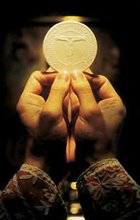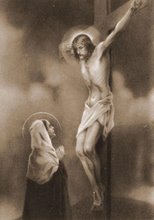
Sunday, December 28, 2008
Christmas Travel

Our Lady of Kibeho VI

The Apparitions of Mary, that followed the first one to Alphonsine, take place in the dormitory until January 16, 1982, and from that date, either in the schoolyard, for public Apparitions, or in the dormitory of the students, or in a place converted into a chapel. It is there that the students come to pray in the evening, and it will be the moment favored by the Blessed Virgin to visit one of the seers of the school. The students are present during the Apparition, and often the talks with the Virgin are about school life. These Apparitions are considered private, and the public is not allowed.
However, all can attend the Apparitions in the schoolyard. There is a conversation between the seer and the Apparition. All can hear and record the words of the seer, but they obviously cannot hear the words of the Virgin Mary. Very soon, the crowds become larger, especially in May, 1982, the month dedicated to Mary.
A podium and powerful speakers are installed to allow journalists and the members of the medical and theological commission to circulate freely, and above all, to allow the population to hear the dialogue of the seers. On August 15, 1982, there were 20,000 people.
Towards the end of an Apparition, the Blessed Virgin asks the seers to bless the crowd. The seers are in ecstasy; they do not see the crowd, but a garden of flowers, some fresh, and others faded. Our Lady asks the seers to water the flowers, and explains that the fresh flowers represent people whose hearts are turned to God, whereas the faded flowers represent those whose hearts are turned to earthly things, especially to money.
Mystical journeys
There are also the mystical journeys. Alphonsine experienced this phenomenon on March 20 and 21, 1982. She informs the Sister directress and her classmates in advance: “I will look dead, but don't be afraid; don't bury me!” The journey lasts eighteen hours. Priests, nurses, religious, the medical assistant of the Red Cross, all can see Alphonsine plunged into a deep sleep, her body straight and very heavy. They cannot lift her nor separate her hands that are joined. During this journey, the Blessed Virgin shows her Heaven, Purgatory, and Hell.
Another impressive phenomenon that took place in Kibeho was the fasts and the silences requested by Jesus or Mary. This was also checked by the commission of inquiry. These fasts could last up to fourteen days, without harming the health of the seers.
Friday, December 19, 2008
Our Lady of Kibeho V
 Marie Claire Mukangango presents the Rosary of Seven Sorrows. She was killed during the war in 1994.
Marie Claire Mukangango presents the Rosary of Seven Sorrows. She was killed during the war in 1994.
The blessing of water
In January and February, 1982, diabolical phenomena take place in the dormitory. To cast away these unknown forces, the nuns use Lourdes' water, which has a soothing effect, but soon there is no more water left. So Anathalie is asked to have some water blessed by the Virgin Mary during the Apparitions. This was on March 2, 1982. Thus started, at Kibeho, the habit of having water blessed by the Virgin Mary before the Apparition.
There are now three seers at Kibeho, all from the college. The three of them are now recognized by the Church: Alphonsine, Anathalie, and Marie Claire.
Thursday, December 18, 2008
Our Lady of Kibeho IV

One knows that the present situation in schools worldwide is awful, because God has been chased out, because His law is no longer taught. It is even forbidden to pray to Him in schools! Every morning, when we go to Mass, our heart breaks when we see school buses arriving to school, loaded with children. Poor little ones, who are taught that God does not exist! Mary came to Kibeho in a school, to set the example to the whole world, and to show how students can be transformed when God's law is taught in schools.
Because of the strong opposition that the first Apparitions had caused, some teachers and students had said: “We will believe in the coming in our school of Mary, the Mother of God, only if She appears to others besides Alphonsine.” The seer replied to them: “Pray yourselves to obtain this favor.”
Tuesday, December 16, 2008
Our Lady of Kibeho - Bonus Post

The rosary recalls the major Seven Sorrows the Blessed Mother suffered through with love and compassion during the life, trials, and agonizing death of her son Jesus Christ.
The Seven Sorrows Rosary is very special to the Immaculate Heart of the Blessed Virgin, and she wants all of us to say it as often as possible. During the Holy Mother’s apparitions to Marie-Claire in Kibeho, she assigned the young visionary with a mission to reintroduce the Rosary of The Seven Sorrows to the world. Before her death during the Rwandan genocide, Marie-Claire travelled widely teaching the rosary to thousands of people, who have taught it to thousands of others. This special rosary has been gaining new international popularity since the Church approved the Marian apparitions in Kibeho in 2001. It is my hope even more people will learn about this amazing rosary.
The following is a description of, and directions for saying, The Seven Sorrows Rosary as the Virgin Mother herself taught it to Marie-Claire in Kibeho. It may be prayed aloud, or in silent contemplation, alone or with others, but the key is for the prayers, reflections, and meditations always to come from the depths of your heart.
During her visitations to Kibeho, the Virgin revealed that The Seven Sorrows Rosary possessed immense spiritual power for those who said it sincerely. She promised that when prayed with an open and repentant heart, the rosary would win us the Lord’s forgiveness for our sins and free our souls from guilt and remorse. She also promised that overtime the rosary would develop within us a deep understating of why we sin, and knowledge would give us he wisdom and strength to change or remove any internal flaws, weaknesses of character, or personality faults causing unhappiness and keeping us from enjoying the joyous life God intended for us to live.
The Rosary of The Seven Sorrows contains all the power you need to change your life for the better, to obtain peace and happiness, to realize your true potential, fulfill all your dreams, and grown closer to God’s light. It is a glorious gift to us from Our Lady of Kibeho; learn how to say it and say it often. I speak from experience when I promise that you will never regret leaning this wonderful rosary and that you will soon lose track of the countless blessing praying with The Seven Sorrows Rosary will bring into your life.
Our Lady of Kibeho III

“It took place on Saturday, November 28, 1981, at 12:35 p.m. I was in the dining room of the school, serving my classmates. All of a sudden, I heard a voice calling me.”
Mary: “My daughter.”
Alphonsine: “Here I am.”
“I went to the corridor, and saw a very beautiful woman. I knelt down, made the Sign of the Cross, and asked: ‘Who are you?’”
Mary: “Ndi Nyina Wa Jambo (in the local language, ‘I am the Mother of the Word’). In the religion, what do you prefer?”
Alphonsine: “I love God and His Mother, who gave us the Child who redeemed us.”
Mary: “If it is so, I have come to calm you, because I have heard your prayers. I would like your friends to have Faith, because they do not believe strongly enough.”
Alphonsine: “Mother of the Saviour, if it is really You who has come to tell us that here, in this school, we have little Faith, You do love us. I am really filled with joy that You appear to me.”
Alphonsine relates: “The Virgin was not white as She is usually seen in holy pictures. I could not determine the color of Her skin, but She was of incomparable beauty. She was barefoot and had a seamless white dress, and also a white veil on Her head. Her hands were clasped together on Her breast, and Her fingers pointed to the sky. Later, I was told that I was in the dining room. My classmates told me that I was speaking in several languages: French, English, Kinyarwanda, etc.
“When the Blessed Virgin was about to leave, I said three ‘Hail Marys’ and the prayer, ‘Come, Holy Spirit’. When She left, I saw Her rise to Heaven like Jesus.”
At the end of the Apparition, the seer remained motionless for a quarter of an hour, as if she was paralyzed, and all the efforts to get her out of ecstasy were in vain. Neither the teachers nor the nuns gave credence to what Alphonsine said. They rather spoke of illness instead of apparitions. (source)
Monday, December 15, 2008
Great Blog Post
Feast day: July 24th
Go here for a MUST read on St. Christine the Astonishing. She is one of my favorite saints, being a lover of the extreme side of Catholicism. A story of a saint such as this begs the question - "Do you really believe this stuff?" And for me, the answer is...yes I certainly do for nothing is impossible for God.
Our Lady of Kibeho II
 Kibeho Seconday School
Kibeho Seconday SchoolIt is in this time of discouragement that Mary chose to visit Rwanda. From 1981 to 1989, this country heard of the Virgin Mary as never before. Kibeho is located in the south of the country, the poorest area of Rwanda. The presence, in this place, of two dynamic priests made the population fervent.
The school of the Apparitions
At the start of the new school year in 1981, there were 120 students, divided into three classes. Three nuns are directing the school. The other teachers – one woman and five men – are lay people. They are all Rwandans. Two are Protestant, the others are Catholic. The majority of the students are Catholic, but there are also 17 Protestant and 2 Moslem students. Morals are far from being exemplary. (source)
Friday, December 12, 2008
Our Lady of Kibeho I

On July 2, 2001, the Holy See released the declaration of Bishop Augustin Misago of Gikongoro, on the Apparitions that took place in 1982-83 in Kibeho. Here are some excerpts:
“Two study commissions, one of doctors and one of theologians, were immediately set up by the local Bishop; they have been at work since April 1982... The advanced state of the study commissions' work now offers sufficient elements to allow competent ecclesiastical authorities to pronounce definitively on this question.
“As a result, Bishop Augustin Misago of Gikongoro, who represents this authority, has published his declaration concerning the definitive judgement on the Apparitions of Kibeho, Rwanda. This important event in the history of the Diocese of Gikongoro, as in the life of the Church in Rwanda, took place on 29 June 2001, on the solemnity of Sts. Peter and Paul, during a solemn Mass concelebrated in the cathedral of Gikongoro. All the Catholic bishops of Rwanda, with the Apostolic Nuncio of Kigali, were present...
“The Bishop declared: Yes, the Virgin Mary appeared at Kibeho on November 28, 1981, and in the months that followed. There are more reasons to believe in the Apparitions than to deny them... The Apparitions of Kibeho are now officially recognized... The name given to the Marian sanctuary at Kibeho is "Shrine of Our Lady of Sorrows". (emphasis added)
“That Kibeho become a place of pilgrimage and of encounter for all who seek Christ and who come there to pray, a fundamental centre of conversion, of reparation for the sins of the world and of reconciliation, a point of meeting for all who were dispersed, as for those who aspire to the values of compassion and fraternity without borders, a fundamental centre that recalls the Gospel of the Cross.
“This Declaration makes it possible to respond to the expectations of the People of God and to bring new enthusiasm to the public devotion recognized already for 13 years”. (Taken from “L'Osservatore Romano”, weekly edition in English, July 11, 2001, page 8.)
In 1988, without officially approving of the Apparitions, Bishop Jean Baptiste Gahamanyi, of the Diocese of Butare, of which Kibeho was a part at that time, authorized public devotion at the site of the Apparitions. Today, Kinbeho is part of the Diocese of Gikongoro, led by Bishop Augustin Misago.
Thursday, December 11, 2008
Blight of Error
 (photo credit) "Tip blight caused by Phomposis"
(photo credit) "Tip blight caused by Phomposis"1. To affect with blight; to blast; to prevent the growth and fertility of.
"[This vapor] blasts vegetables, blights corn and fruit, and is sometimes injurious even to man." --Woodward.
2. Hence: To destroy the happiness of; to ruin; to mar essentially; to frustrate; as, to blight one's prospects.
"Seared in heart and lone and blighted." --Byron.
"A blight seemed to have fallen over our fortunes." --Disraeli.
For all those abused by those whose duty it is to care...
 "In 1601 she was found dead on her straw pallet under the stairs, and she was buried in the Church of Pibrac opposite the pulpit. When accidentally exhumed in 1644 during a renovation, her body was found incorrupt."
"In 1601 she was found dead on her straw pallet under the stairs, and she was buried in the Church of Pibrac opposite the pulpit. When accidentally exhumed in 1644 during a renovation, her body was found incorrupt." ~ Picture of St. Germaine Cousin's incorrupt body
~ Picture of St. Germaine Cousin's incorrupt bodyDocuments attest to more than 400 miracles or extraordinary graces through the intervention of Saint Germain. They include cures of every kind (of blindness, both congenital and resulting from disease, of hip and spinal disease), and the multiplication of food for the distressed community of the Good Shepherd at Bourges in 1845.
Monday, December 8, 2008
The 56 Meme

Thursday, December 4, 2008
Persecution & Hope
Did Jesus always know He was God??
The answer of course is YES. Go here for an excellent post explaning this better than I could: "Q: Was Jesus confused about who He was and what He was here for? A. No. He always knew Who He was and what He was here for. He was NOT confused. However, there are many theologians who are confused." LOL!
I cannot tell you how often this error in understanding of the nature of Jesus comes up. I have been told on several occasions that Jesus did not know He was God until the earlier part of His ministry, or until the Transfiguration or some other stupid time. Jesus always was, always is and always will be the Eternal Word, the all knowing, all seeing, omnipotent GOD. May His name be blessed forever!
Here is a list of associated common and condemned heresies:
Adoptionism- God granted Jesus powers and then adopted him as a Son. He was not eternally existent with the Father, He was adopted by the Father after testing at his baptism. (I used to believe this-no one taught it to me.)
Apollinarianism- Jesus’ divine will overshadowed and replaced the human.
Arianism - Jesus was a lesser, created being.
Docetism- Jesus was divine, but only seemed to be human.
Gnosticism - Dualism of good and bad and special knowledge for salvation.
Kenosis - Jesus gave up some divine attributes while on earth.
Modalism - God is one person in three modes. Father, Son, and Holy Spirit just three names for same, one person, God.
Monophysitism- Jesus had only one nature: divine. He was not fully human.
Nestorianism - Jesus was two persons. Mary did not give birth to God the Son
Socinianism - Denial of the Trinity. Jesus is a deified man.
Tuesday, December 2, 2008
Blessed Virgin Mary's Wedding Ring?

Thank you to Vincenzo who sent me a link to this image. This ring is located in the Cattedrale Santo Anello. Again, I cannot read italian so I'm posting this here in the hopes that someone can go to this site and interpret for us what is said of this ring.
Here is the description Blessed Anne Catherine Emmerich gives of the Blessed Virgin Mary's wedding ring: "I saw the Blessed Virgin’s wedding-ring; it is neither of silver nor of gold, nor of any other metal; it is dark in color and iridescent; it is not a thin narrow ring, but rather thick and at least a finger broad. I saw it smooth and yet as if covered with little regular triangles in which were letters. On the inside was a flat surface. The ring is engraved with something. I saw it kept behind many locks in a beautiful church. Devout people about to be married take their wedding-rings to touch it. "
If this is Mary's ring, this would be an apt description of it.
Tuesday, November 25, 2008
Is the Holy Grail really lost?


contains an agate cup which many people believe to have been used by Christ during the last supper.
 Our Holy Father John Paul II venerating this same chalice. He later said mass using it - it was also said this was the first "Peter" to say mass with this chalice since St. Peter.
Our Holy Father John Paul II venerating this same chalice. He later said mass using it - it was also said this was the first "Peter" to say mass with this chalice since St. Peter.
Food for thought...we most likely will not know until all is revealed at the end of time.
Missing Holy Relic

Beautiful Mary Holding Jesus II
Our Lady of Sorrows at the Hour of our Death
 (picture source)
(picture source)Holy Mass

Monday, November 24, 2008
St. Winifred

Thursday, November 20, 2008
Lilies of the Valley

Tuesday, November 18, 2008
Beautiful Mary
 Ok, I'm busy and stressed and I just need sometimes to look upon the beautiful face of Mary and know that she is the Queen of Heaven and I am so honored and so unworthy to have her as my intercessor. Thank you Mary Mother of God for all your prayers, all your suffering on behalf of us poor sinners. I place all my worries and cares at your feet as so many peices of straw.
Ok, I'm busy and stressed and I just need sometimes to look upon the beautiful face of Mary and know that she is the Queen of Heaven and I am so honored and so unworthy to have her as my intercessor. Thank you Mary Mother of God for all your prayers, all your suffering on behalf of us poor sinners. I place all my worries and cares at your feet as so many peices of straw.Monday, November 17, 2008
Purgatorian Archconfraternity

“Oh no! That is not sufficient. It is the Blood of Jesus Christthat is needed to extinguish the flames by which I am consumed;it is the August Sacrifice that will deliver me from these frightful torments.”
(A Soul from Purgatory to Bl. Henry Suso)
Friday, November 14, 2008
Persecution cometh...
Thursday, November 13, 2008
Prayer invoking Mary's Tears

Healer of the sorrows of Eve, change my day of anguish
O you who are blessed among women, help me with your tears
Be solicitous for me for I am miserable.
Tuesday, November 11, 2008
Indulgences for Dummies
 (photo credit to Micki at Holy Cards for your Inspiration)
(photo credit to Micki at Holy Cards for your Inspiration)Monday, November 10, 2008
What are Indulgences?

Friday, November 7, 2008
How to Help the Holy Souls

Thursday, November 6, 2008
Beautiful Holy Card

Another simply incredible holy card from Micki and Holy Cards for your Inspiration. And this right after returning from a week in Nashville!
What Does it Mean to Pray for the Poor Souls?

~We can offer our bodily pains in expiation for their sins.
~We can offer our spiritual sufferings, our disappointments and fears, our discouragement and estrangement from those we love.
~We can offer our vocal prayers, like the Rosary, the Memorare, the Angelus, the recitation of the Divine Office.
~We can offer our mental prayers, like the Way of the Cross, our daily meditation and examination of conscience.
~We can offer our mortifications, like giving up some delicacy at table, or performance of some unpleasant work.
May I offer a recommendation? During the month of November, I suggest that we make a list of all the deceased persons whom we wish to specially remember in our Masses, prayers and sacrifices for the repose of their souls. Add to this list as those enter eternity whom you wish to specially commend to the mercy of God. This, by the way, is called a Necrology. Every Catholic diocese in the world has a Necrology of its deceased priests. Every family should have its own Necrology of deceased members whom we daily remember to our merciful Lord.
Every time you say the grace after meals, be sure to add the invocation, "May the souls of the faithful departed, through the mercy of God, rest in peace. Amen." In every Rosary you recite, do not forget to say after each decade, " O, my Jesus, forgive us our sins, save us from the fires of hell, and bring all souls to heaven, especially those who are in most need of thy mercy."
Remember that devotion to the Poor Souls is really a covenant between them and us. We pray and sacrifice for them, They can pray and suffer for us. They appreciate whatever help we give them, to lessen their suffering and to shorten their stay in Purgatory. They will continue to show their appreciation when we join them in a heavenly eternity.
Tuesday, November 4, 2008
The Truth about Liberalism

John 14:2 In my Father's house are many rooms; if it were not so, I would have told you. I am going there to prepare a place for you.
John 14:3 And if I go and prepare a place for you, I will come back and take you to be with me that you also may be where I am.
John 14:4 You know the way to the place where I am going."
John 14:5 Thomas said to him, "Lord, we don't know where you are going, so how can we know the way?"
John 14:6 Jesus answered, "I am the way and the truth and the life. No one comes to the Father except through me.
The Two Sides of Purgatory

On their side, the Poor Souls are united with us in the one Kingdom of Christ. They can pray and obtain blessings for us here on earth. They are united, as the Second Vatican Council teaches, with the pilgrim Church in the Communion of Saints. We are therefore encouraged to invoke their aid, with a confidence of being heard by those who understand our needs. They know from their own experience what it means to carry the cross here on earth.
On our side we are to do everything we can to help the Poor Souls in the Church Suffering. The sufferings in purgatory are not the same for all. They depend on each person's degree of sinfulness. St. Thomas Aquinas held that the least pain in purgatory is greater than the worst pain in this life. St. Bonaventure held that the worst suffering after death was greater than the worst suffering on earth, but the same could not be said regarding the least pain in purgatory. In general, however, we should say that the pains of purgatory are greater than those on earth.
To atone for your sins...

Monday, November 3, 2008
Why are Souls in Purgatory?

Mortal sins are called mortal because they deprive the sinner of sanctifying grace and the right to heaven. Mortal sins also incur the debt of eternal punishment.
When mortal sins are forgiven in the sacrament of penance, sanctifying grace is restored and the debt of eternal punishment is removed. But normally there is still temporal punishment to be expiated. Moreover, venial sins always carry with them a debt of temporal punishment, which is more or less remitted, depending on a person's spiritual dispositions.
This immediately tells us that because we are sinners we must expect to suffer in expiation for our sins. The choice we have is between patiently suffering here on earth or suffering in purgatory after our bodily death.
November if the Month of the Holy Souls

The Poor Souls are the souls of those people who died in the friendship of God. But they still have some suffering to undergo for the sins they had committed during their lives on earth. It is the infallible teaching of the Catholic Church that there is a purgatory. As the word itself indicates, purgatory is the state of those who still have to be cleansed of the penalty which they owe for their past offenses against God.
The Poor Souls are poor because they are in suffering and need our help. We know from Sacred Scripture that there is a purgatory, as described in the second book of Maccabees, which unfortunately has been removed from the Protestant Old Testament. As described in Sacred Scripture, Judas Maccabeus, the leader of a Jewish army, decided to offer a sacrifice for the Jews who had died in battle. The Bible then tells us,"If he had not expected the fallen to rise again, it would have been superstitious and foolish to pray for the dead." However, since he believed in the resurrection of the dead, "he had this atonement sacrifice offered for the dead, so that they might be released from their sins" (II Maccabees 12:41?45).
The existence of purgatory is a defined truth of the Catholic faith. Those who die without the guilt of mortal sin, but with temporal punishment still due for their past offenses "are cleansed after death in purgatorial or cleansing punishments."
It is commonly believed that the principal suffering in purgatory is the pain of loss. The souls are temporarily deprived of the Beatific Vision.
Wednesday, October 22, 2008
Holy Sonnet


Going out of town

Monday, October 20, 2008
Would like your input...

Friday, October 17, 2008
A Challenge for the World

Thursday, October 16, 2008
Tuesday, October 14, 2008
St. Agnes of Rome ~ My Daughter's Paton Saint


St Agnes Virgin Martyr
Holy Agnes was martyred on 21st January c305 AD in the Piazza Navona in Rome, at the tender age of twelve or thirteen. The son of the Governor of Rome proposed marriage, but Agnes preferred virginity. Her refusal to accept his hand, sent the Governor into a rage, and he threatened to expose Agnes’s parents as Christians, and so face certain death. He tried to persuade Agnes to change her mind by making her walk naked through the city, but her hair miraculously grew to cover her body and save her nakedness. This could not change her mind, so Agnes was burned at the stake, but the flames refused to touch her. She was sent to the lions, who made no attack on her. The son of the Governor goaded the lions who then attacked and killed him. The Father, distraught at his son’s death, pleaded with Agnes to pray for him, and at her intercession he was restored to health. Undeterred, the Governor had Agnes beheaded. Her body was buried in the Catacombs outside the city. On the octave day, she appeared in a vision, full of assurance of her well-being.
Her preference of death, rather than any violation to her young sacred body won her much renown in the early Church, most especially in Europe.
Her severed head is in the Church of Sant’ Agnese in Agone in the Piazza Navona. Her body is in the Basilica of Sant’ Agnese fuori le Mura (St Agnes outside the Walls) on the Via Nomentana.
Because of the resemblance of her name, Agnes to agnus (latin for lamb) she is often represented in Art carrying a lamb. And, on her feast day in the Basilica of St Agnes the Holy Father blesses lambs, from which the sisters of St Agnes’ convent make the Sacred Pallia, worn by Archbishops. Once the Pallia are made, they rest above the tomb of St Peter in the Vatican, from where new Archbishops receive them from the Holy Father.
We celebrate with her and all the saints, their victory over death and suffering through Jesus. We also pray and hope that we will be amongst their number and remain loyal to the faith which she professed, live and died by.
Holy Agnes, pray for us and for my daughter until she stand beside you in heaven!


















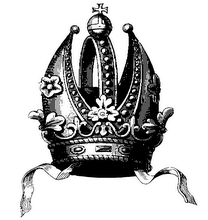
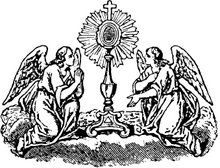








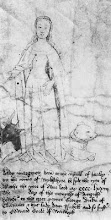01.jpg)














